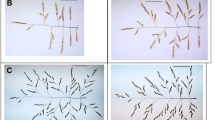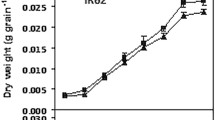Abstract
The erect panicle architecture has contributed to the improvement of yield in japonica rice breeding, and recent molecular analysis has revealed the mechanisms involved in individual plant yield increases. However, the population structure is more important in rice production compared with individual plant yield. Our study compared the population canopy structure of a curved panicle variety Sasanishiki (WT) and an erect panicle mutant derived from CRISPR/Cas9 gene editing at the DENSE AND ERECT PANICLE 1 (DEP1) locus. The results showed that more light could reach to the leaves under the panicle in the CRISPR-dep1 population compared with the WT. The canopy of the CRISPR-dep1 population exhibited higher temperature and lower humidity compared with the WT after heading. A subsequent survey showed that the CO2 concentration in the CRISPR-dep1 population was significantly lower than that in the WT population from full heading to 15 days after heading. Moreover, the increase of biomass in the CRISPR-dep1 population was greater than that in the WT. We noticed that the CRISPR-dep1 mutant could achieve higher yield under low fertilization application compared with the WT under high fertilizer application through increased transplant density. These traits could contribute to an agricultural sustainable development strategy. The quality investigation showed that the dep1 allele increased the yield along with imposing a penalty on grain quality. Our study not only elucidated the mechanism of yield improvement in an erect panicle architecture variety from the perspective of population structure optimization but also provides a theoretical basis for supporting cultivation systems with the erect panicle architecture.






Similar content being viewed by others
References
Huang X, Qian Q, Zhengbin L, Hongying S, Shuyuan H, Da L, Guangmin X, Chengcai C, Jiayang L, Xiangdong F (2009) Natural variation at the DEP1 locus enhances grain yield in rice. Nat Genet 41(4):494–497
Islam MS, Morison JIL (1992) Influence of solar radiation and temperature on irrigated rice grain yield in Bangladesh. Field Crop Res 30(1–2):13–28
Khush GS (1999) Green revolution: preparing for the 21st century. Genome 42(4):646–655
Li M, Xiaoxia L, Zejiao Z, Pingzhi W, Maichun F, Xiaoping P, Qiupeng L, Wanbin L, Guojiang W, Hongqing L (2016) Reassessment of the four yield-related genes Gn1a, DEP1, GS3, and IPA1 in rice using a CRISPR/Cas9 system. Front Plant Sci 7
Li X, Tao X, Miao J, Yang Z, Gu M, Liang G, Zhou Y (2019) Evaluation of differential qPE9-1/DEP1 protein domains in rice grain length and weight variation. Rice 12(1):5
Li X, Wu L, Wang J, Sun J, Xia X, Geng X, Wang X, Xu Z, Xu Q (2018) Genome sequencing of rice subspecies and genetic analysis of recombinant lines reveals regional yield- and quality-associated loci. BMC Biol 16(1):102
Ma X, Zhang Q, Zhu Q, Liu W, Chen Y, Qiu R, Wang B, Yang Z, Li H, Lin Y (2015) A robust CRISPR/Cas9 system for convenient, high-efficiency multiplex genome editing in monocot and dicot plants. Mol Plant 8(8):1274–1284
Peng J, Richards Donald E, Hartley Nigel M, Murphy George P, Devos Katrien M, Flintham John E, James B, Fish Leslie J, Worland Anthony J, Fatima P (1999a) Green revolution’genes encode mutant gibberellin response modulators. Nature 400(6741):256–261
Peng S, Cassman Kenneth G, Virmani SS, Sheehy J, Khush GS (1999b) Yield potential trends of tropical rice since the release of IR8 and the challenge of increasing rice yield potential.
Peng S, Jianliang H, Sheehy John E, Laza Rebecca C, Visperas Romeo M, Xuhua Z, Centeno Grace S, Khush Gurdev S, Cassman Kenneth G (2004) Rice yields decline with higher night temperature from global warming. Proc Natl Acad Sci U S A 101(27):9971
Peng S, Khush Gurdev S, Parminder V, Qiyuan T, Yingbin Z (2008) Progress in ideotype breeding to increase rice yield potential. Field Crop Res 108(1):32–38
Qian Q, Longbiao G, Smith Steven M, Jiayang L (2016) Breeding high-yield superior-quality hybrid super-rice by rational design. National Science Review, p nww006
Shan Q, Wang Y, Li J, Zhang Y, Chen K, Liang Z, Zhang K, Liu J, Xi JJ, Qiu JL (2013) Targeted genome modification of crop plants using a CRISPR-Cas system. Nat Biotechnol 31(8):686–688
Shen L, Yufeng H, Yaping F, Jian L, Qing L, Xiaozhen J, Gaowei X, Junjie W, Xingchun W, Changjie Y (2017) Rapid generation of genetic diversity by multiplex CRISPR/Cas9 genome editing in rice. Sci China Life Sci 60(5):506–515
Sun S, Lei W, Hailiang M, Lin S, Xianghua L, Jinghua X, Yidan O, Qifa Z (2018) A G-protein pathway determines grain size in rice. Nat Commun 9(1):851
Virmani SS, Aquino RC, Khush GS (1982) Heterosis breeding in rice (Oryza sativa L.). Theor Appl Genet 63(4):373–380
Wang J, Tetsuya N, Shuqian C, Wenfu C, Hiroki S, Takuji T, Yutaka O, Zhenjin X, Takatoshi T (2009) Identification and characterization of the erect-pose panicle gene EP conferring high grain yield in rice (Oryza sativa L.). Theor Appl Genet 119(1):85–91
Wang Y, Lizhao G, Menglong Y, Juan W, Chen J, Min L, Kun Y, Ya Z, Huaibing J, Eric W (2017) Deletion of a target gene in Indica rice via CRISPR/Cas9. Plant Cell Rep 36(8):1–11
Xu H, Zhao M, Zhang Q, Xu Z, Xu Q (2016a) The dense and erect panicle 1 (DEP1) gene offering the potential in the breeding of high-yielding rice. Breed Sci 66(5):659–667
Xu Q, Mingzhu Z, Kun W, Xiangdong F, Qian L (2016b) Emerging insights into heterotrimeric G protein signaling in plants. Journal of Genetics and Genomics
Yoshida S, Parao FT (1976) Climatic influence on yield and yield components of lowland rice in the tropics. Climate & Rice
Yuan LP (1998a) Hybrid rice breeding in China. Advances in Hybrid Rice Technology. Philippines, International Rice Research Institute, pp 27–33
Yuan L (1998b) Hybrid rice breeding for super high yield. 21st century: 10
Funding
The National Natural Science Foundation of China (U1708231) supported this study.
Author information
Authors and Affiliations
Corresponding author
Ethics declarations
Conflict of interest
The authors declare that they have no competing interests.
Additional information
Publisher’s note
Springer Nature remains neutral with regard to jurisdictional claims in published maps and institutional affiliations.
Electronic supplementary material
ESM 1
Fig. S1 The pedigree of Sasanishiki. Fig. S2 The light penetration of canopy in 2017. (a) The light penetration from canopy to 40 cm from the canopy in DEP1 at full heading stage. (b) The light penetration from canopy to 40 cm from the canopy in CRISPR-dep1 at full heading stage. (c) The light penetration from canopy to 40 cm from the canopy in DEP1 at full ripeness stage. (d) The light penetration from canopy to 40 cm from the canopy in CRISPR-dep1at full ripeness stage. Fig. S3 The temperature and humidity of canopy in 2017. (a) The canopy temperature in the DEP1 and CRISPR-dep1populations at full heading stage. (b) The canopy temperature in the DEP1 and CRISPR-dep1populations at full ripeness stage. (c) The canopy humidity in the DEP1 and CRISPR-dep1populations at full heading stage. (d) The canopy humidity in the DEP1 and CRISPR-dep1populations at full ripeness stage. (PPTX 177 kb)
Rights and permissions
About this article
Cite this article
Fei, C., Yu, J., Xu, Z. et al. Erect panicle architecture contributes to increased rice production through the improvement of canopy structure. Mol Breeding 39, 128 (2019). https://doi.org/10.1007/s11032-019-1037-9
Received:
Accepted:
Published:
DOI: https://doi.org/10.1007/s11032-019-1037-9




